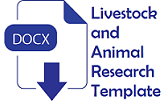Identification of factors causing reproductive disorders of the cow found in North Labuhanbatu Regency, North Sumatera Province
Abstract
Objective: This study aims to identify the factors that cause reproductive disorders in beef cattle in the North Labuhanbatu, North Sumatra.
Methods: The objects of this study were cattle with reproductive disorders and breeders whose cattle had reproductive disorders. This research used a survey method. Primary data was obtained by distributing questionnaires and conducting direct interviews with breeders, while secondary data was obtained by studying the 2017 report of UPSUS SIWAB (Indonesian Ministry of Agriculture's program to accelerate the fulfilment of domestic beef cattle population targets) in North Labuhanbatu Regency. The questionnaire covered the characteristics of cow with reproductive disorders including body condition score (BCS), type of cows, feed given to cows with reproductive disorders, maintenance management, veterinary/medical personnel visits, pregnancy checks, heat synchronization, birth assistance, type of mating, and the breeders identity. This questionnaire was distributed to 30 breeder respondents in 5 districts. Data were analyzed using stepwise regression with SPSS.
Results: The results showed that 110 cows had reproductive disorders, 57.3% of which experienced hypofunctional ovaries. The independent variable that has the strongest correlation to the dependent variable is the body condition score (sig. 0.043), followed by the feed given to the cows (sig. 0.046) with the regression equation Y = -4.297 + 1.495X1 + 2.492X2.
Conclusions: The identified factors that had correlation to reproductive disorders in female beef cattle are body condition score and feed.
Keywords
Full Text:
PDFReferences
- Kementan. 2016. Upaya Khusus Percepatan Peningkatan Populasi Sapi dan Kerbau Bunting. Permentan. No 48/ Permentan/PK.210/10/2016. Jakarta, ID.
- Inounu, I. 2017. Dukungan sains dan teknologi reproduksi untuk mensukseskan program sapi indukan wajib bunting. Wartazoa. 27(1):23-34. Doi: 10.14334/ wartazoa.v27i1.1368
- Gitonga, P.N. 2010. Postpartum reproductive performance of dairy cows in medium and large scale farms in kiambu and nakuru districts of Kenya. Doctoral Dissertation, University of Nairobi. Nairobi, KE.
- Rusdiana, S., and L. Praharani. 2018. Development of people's people livestock: SWAT private vocational policy and feasibility of animal businesses. Forum Penelitian Agro Ekonomi. 36(2): 97-116. Doi: 10.21082/fae.v36n2.2018.97-116
- Ariningsih, E. 2014. Performance of national beef self-sufficiency policy. Forum Penelitian Agro Ekonomi, 32(2):137-156.
- Utara, B. P. S. K. L. 2016. Populasi Ternak Menurut Kecamatan dan Jenis Ternak di Kabupaten Labuhanbatu Utara 2016. Labuhanbatu Utara, ID.
- Luthfi, M., and Y. Widyaningrum. 2017. Tingkat kejadian gangguan reproduksi sapi bali dan madura pada sistem pemeliharaan kandang kelompok. Pros. Semnas TPV. p. 101-108. Doi: 10.14334/Pros.Semnas.TPV-2017
- Partodiharjo, S. 1987. Ilmu Reproduksi Hewan. Mutiara Sumber Widya, Jakarta, ID.
- Sutiyono, D. S., and A. Suryawijaya. 2017. Identifikasi gangguan reproduksi sapi betina di peternakan rakyat. J. Vet. 18(4): 580-588. Doi: 10.19087/jveteriner.2017.18. 4.580
- Singh, J., D. Dadarwal, M. Honparkhe, and A. Kumar. 2009. Incidences of various etiological factors responsible for repeat breeding syndrome in cattle and buffaloes. Internet J. Vet. Med. 6(1): 1-6.
- Ahmed, F. O., and A. S. Elsheikh. 2014. Treatment of repeat breeding in dairy cows with Lugol's Iodine. IOSR J. Agric. Vet. Sci. 7(4): 22-26.
- Britt, J. H. 2008. Oocyte development in cattle: physiological and genetic aspects. Rev. Bras. Zootech. 37:110-115. Doi: 10.1590/S1516-35982008001300013
- Luo, R., and X. Gu. 2009. Treating infertile milk cows by traditional Chinese medicine. J. Agricult. Sci. 1(1):82-85. Doi: 10.5539/jas.v1n1p82
- Williams, E. J., D. P. Fischer, D. U. Pfeiffer, G. C. England, D. E. Noakes, H. Dobson, and I. M. Sheldon. 2005. Clinical evaluation of postpartum vaginal mucus reflects uterine bacterial infection and the immune response in cattle. Theriogenology. 63(1): 102-117. Doi: 10.1016/j.theriogenology.2004 .03.017
- Susilorini, T. E., and M. E. Sawitri. 2008. Budidaya 22 ternak potensial. Penebar Swadaya Grup, Jakarta, ID.
- Budiawan, A., M. N. Ihsan, and S. Wahjuningsih. 2015. Hubungan body condition score terhadap service per conception dan calving interval sapi potong Peranakan Ongole di Kecamatan Babat Kabupaten Lamongan. J. Trop. Anim. Product. 16(1):34-40.
- Bearden, H. J., and J. W. Fuquay. 1984. Applied Animal Reproduction. Reston Publishing Company Inc., Virginia, US.
- Direktorat Jenderal Peternakan dan Kesehatan Hewan. 2016. Pedoman Teknis Gangguan Reproduksi. Jakarta, ID.
- Eversole, D. E., M. F. Browne, J. B. Hall, R. E. Dietz. 2009. Body condition scoring beef cows. Life Sciences, Virginia Polytechnic Institute and State University, US.
- Pradhan, R., and N. Nakagoshi. 2008. Reproductive disorders in cattle due to nutritional status. J. Int. Developm. Cooperation. 14(1):45-66.
- Nuryadi, N., and S. Wahjuningsih. 2012. Penampilan reproduksi sapi peranakan Ongole dan peranakan Limousin di Kabupaten Malang. J. Trop. Anim. Product. 12(1):76-81.
- Winugroho, M. 2002. Strategi pemberian pakan tambahan untuk memperbaiki efisiensi reproduksi induk sapi. J. Lit. Bang. Perta. 21(1):19-23.
- Bindari, Y. R., S. Shrestha, N. Shrestha, and T. N. Gaire. 2013. Effects of nutrition on reproduction-A review. Adv. Appl. Sci. Res. 4(1):421-429.
- Gupta, D. 2015. Study on sterile and sub-sterile conditions in cow and buffalo in Mawana tehsil of District Meerut Uttar Pradesh. Res. J. Anim. Husb. Dairy Sci. 6(1):83-84. Doi: 10.15740/HAS/RJAHDS/6.1/83-84
Refbacks
- There are currently no refbacks.










